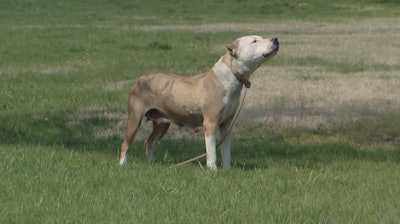 Just because a dog looks like a pit bull does not mean it is "vicious" or even "aggressive. You can only judge the animal as a threat by its actions. (Photo: National Canine Research Council)
Just because a dog looks like a pit bull does not mean it is "vicious" or even "aggressive. You can only judge the animal as a threat by its actions. (Photo: National Canine Research Council)
Most shootings of pet dogs by law enforcement officers involve large and medium breed dogs that are considered “dangerous,” including Rottweilers, German shepherds, and pit bulls. But it’s important for officers to know that a shooting can’t be justified just by the perceived breed of the dog.
Dogs referred to as pit bulls are particularly prone to being shot by officers. And many dog behavior experts believe this is because of the breed’s bad press. It is often true that the only dog breed specifically named in stories about dog bites is the "pit bull."
The “pit bull” was originally bred in England by mating mastiffs with terriers. The goal of the breeders was to create a dog with the power of a mastiff and the never-quit spirit of a terrier that could be used for sport such as bear baiting and bull baiting and dog fighting. Contrary to popular belief the dog was not bred to attack humans, in fact that would be the last thing that the dog handlers working in the ring during dog fights would want.
Today, pit bulls are still used for sport, but they are more likely to be family pets and protection animals (sometimes by bad guys who use them as weapons) Pit mixes are now some of the most common dogs in America. The pit and pit mix population is now so hight in this country that Esquire magazine recently called them "The American Dog."
Unfortunately, the American dog is not very well loved. Each day thousands of them are destroyed in shelters nationwide because their ownership is outlawed in that community, because people are afraid of adopting them, because apartments and homeowner associations ban them, and/or because some insurance companies won't write home policies for people who own them.
Dog trainers and dog behaviorists will tell you that despite their fearsome reputation and the dog bite statistics that are often used to damn them, the vast majority of pit bulls are no more dangerous than any other large pet dog.
“My heart goes out to these dogs,” says trainer Brian Kilcommons, who has worked with 40,000 dogs and who is often called to assess the aggressiveness and socialization of pits. “These dogs are so maligned. They are tortured. They are fought. I cannot tell you how many of these dogs I have trained that make phenomenal pets.”
Kilcommons also warns officers that making an assumption that a dog is vicious because it is a pit bull can lead the people around the dog, including the officer, to be afraid, which can elicit an aggressive response from the dog. “Once you start working off of fear, the signals you are giving that dog are very confusing,” he says.
Another problem that officers often have when encountering dogs that appear to be pit bulls is that they put that description in their reports. And that's a big mistake because even dog experts can have difficulty judging the breed of an animal without a DNA test. Calling a dog a "pit" in your report when it isn't one can lead to a smart lawyer challenging you in court over that identification.
“They’ve got to stop calling every dog a ‘pit bull,’” says Jim Osorio, lead trainer for police training company Canine Encounters. Osorio tells the story of a trainer who used to put 100 photos of dogs on a chart and ask people to identify which ones were pit bulls. The vast majority of people identified most of the dogs as pits. Only two were actually purebred “pit bulls.”
Osorio also points out that several different breeds are included in the “pit bull” classification, including the American Pitbull Terrier, the American Staffordshire Terrier, and the Staffordshire Bull Terrier. “Pit bull is a nickname,” he says.
And even if you can identify a pit bull by sight, just because a dog is a pit or pit mix does not mean it necessarily will be aggressive or more aggressive than any other dog in the same circumstance.
“There’s an overemphasis on the viciousness of particular dog breed,” says Cynthia Bathurst, founder of Safe Humane Chicago. She adds that determining the behavior of a dog by its physical appearance is a losing game, “One-quarter of one percent of a dog’s DNA determines what a dog’s head looks like.”
Kilcommons cautions officers not to believe the media hype about certain dog breeds. “Generalizations don’t work. It’s not the breed; it’s the deed,” he explains.


















